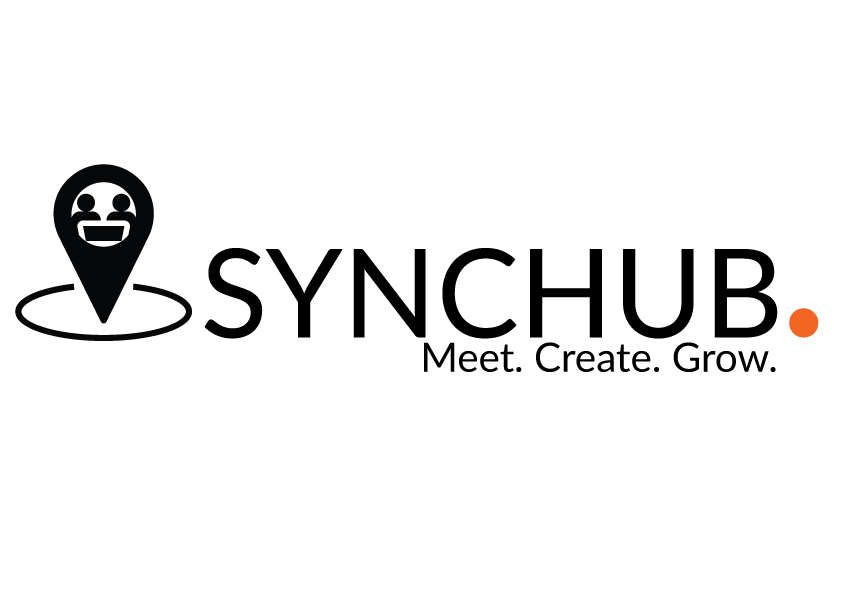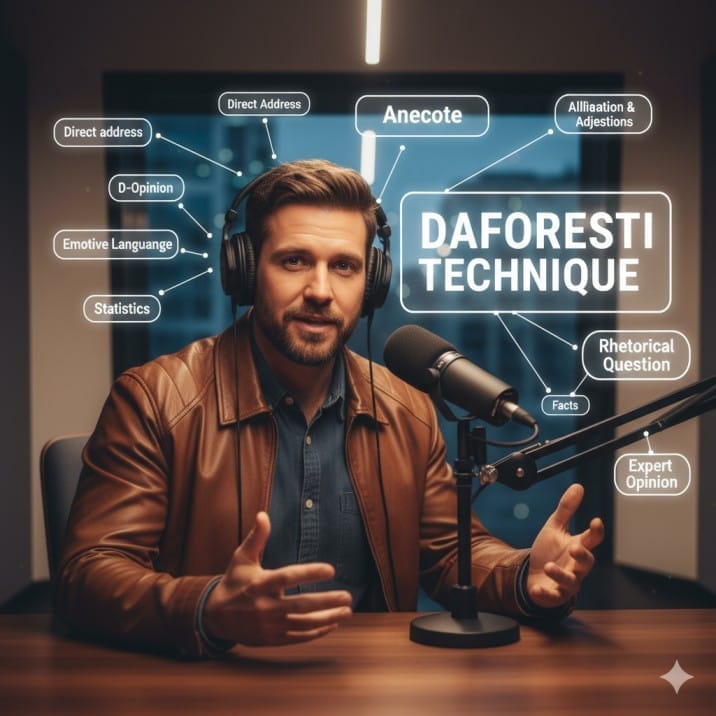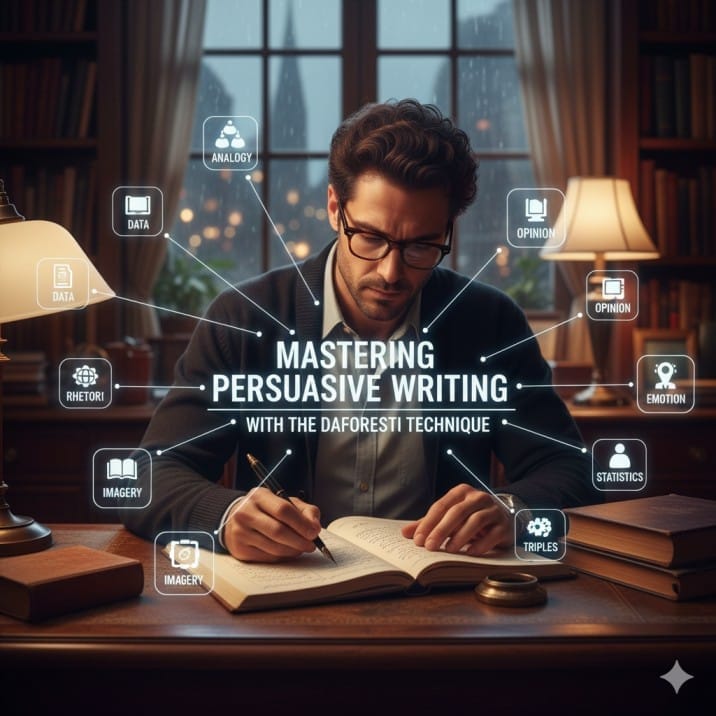
Mastering Persuasive Writing with the DAFORESTI Technique
Lesson#1: Listen. Watch. Learn. — Mastering Persuasive Writing with the DAFORESTI Technique
Whether you’re writing an essay, crafting a speech, or creating a marketing campaign, persuasive writing is one of the most valuable skills you can master. Great persuasion doesn’t happen by chance — it’s built on strategy, structure, and psychology. In our podcast and video lesson, you’ll discover how to use the DAFORESTI Technique to write with clarity, confidence, and impact — transforming your ideas into messages that truly connect and convince.
Lesson 2: Persuasive Techniques — Presented by Alexander Lyon
This is your second lesson in the short course. In this session, Alexander Lyon breaks down the key persuasive techniques that help you influence others with authenticity, clarity, and confidence. Watch the video below to learn how to communicate ideas that inspire action and drive meaningful results.
What Is DAFORESTI?
DAFORESTI stands for:
D – Direct Address
A – Anecdote
F – Facts
O – Opinion
R – Repetition & Rhetorical Question
E – Emotive Language & Expert Opinion
S – Statistics
T – Triple
I – Imperative
Each of these techniques plays a unique role in shaping a message that informs, engages, and persuades. Not every technique fits every piece of writing—but knowing how and when to use them gives you the power to influence minds and move hearts.


D — Direct Address
Definition: Speaking directly to the audience using the word you.
Purpose: Creates a personal connection and draws the reader or listener into the message.
Example:
Barack Obama, in his farewell speech, said:
“Every day I learned from you. You made me a better president, and you made me a better man.”
This simple use of “you” instantly makes people feel seen and included.
✅ Use it when: You want to build trust or motivate your audience to take action.
A — Anecdote
Definition: A short, personal story that illustrates a point.
Purpose: Makes your message more relatable and emotionally impactful.
Example:
At the VMAs, Pink shared a story about a conversation with her six-year-old daughter about self-image. That story connected her message about confidence to a deeply human moment.
✅ Use it when: You want your audience to connect emotionally or see your perspective as genuine.


F — Facts
Definition: Information that is proven or verified to be true.
Purpose: Builds credibility and helps convince logical thinkers.
Example:
“Research shows that people who sleep less than six hours a night are 30% more likely to experience burnout.”
Facts anchor your argument in reality.
✅ Use it when: You need to support your claims with solid evidence.
O — Opinion
Definition: A personal belief or viewpoint about a topic.
Purpose: Clearly states your position and persuades the reader to see your side.
Example:
“I believe every child deserves access to quality education, regardless of where they are born.”
✅ Use it when: You want your audience to understand your stance and the reasoning behind it.


R — Repetition & Rhetorical Question
Definition: Repeating key words or phrases for emphasis.
Example:
“I have a dream…” — Martin Luther King Jr. repeated this phrase to reinforce his vision and inspire millions.
✅ Use it when: You want your message to stick in people’s minds.
Rhetorical Question
Definition: A question asked for effect, not an answer.
Example:
“If not now, when? If not us, who?”
✅ Use it when: You want to make your audience pause and think deeply.
E — Emotive Language & Expert Opinion
Emotive Language
Definition: Words that evoke strong emotions—joy, sadness, fear, or hope.
Purpose: Moves your audience emotionally, not just logically.
Example:
“Every day, thousands of children go to bed hungry. Together, we can change that.”
✅ Use it when: You want your readers to feel something that motivates action.
👩⚕️ Expert Opinion
Definition: Quoting professionals or authorities on a subject.
Purpose: Adds credibility and strengthens your argument.


S — Statistics
Definition: Using numbers, data, or percentages to support your argument.
Purpose: Makes your writing sound logical and evidence-based.
Example:
“Nine out of ten people agree that recycling helps protect the environment.”
✅ Use it when: You need to convince readers through logic and proof.
T — Triple
Definition: Using a group of three words, phrases, or ideas to make a point.
Purpose: Creates rhythm and makes messages more memorable.
Example:
“Blood, sweat, and tears.”
“Reduce, reuse, recycle.”
✅ Use it when: You want to give your writing a strong, memorable flow.


I — Imperative
Definition: Giving a command or instruction.
Purpose: Encourages your audience to take action immediately.
Example:
“Join us today.”
“Make a difference.”
“Stand up for what’s right.”
✅ Use it when: You want to inspire or motivate action.
Bringing It All Together
The DAFORESTI framework gives writers and speakers a complete toolkit for persuasion. Whether you’re:
Writing an essay or advertisement,
Delivering a motivational speech, or
Creating educational or social media content,
Using a combination of these techniques can make your message more powerful, engaging, and unforgettable.
Remember: not every technique fits every context. Great communicators know how to choose the right mix based on their audience and purpose.

Final Thought
Persuasive writing is more than using powerful words — it’s about creating a real connection with your audience. The DAFORESTI techniques help you balance emotion, logic, and credibility, turning your message into something people truly feel and believe. Before you move on, take a moment to watch the video lesson below for deeper understanding. It brings these techniques to life and shows how each element works together to make your writing more impactful.
Enrol for the Full Course
Mastering Persuasive Writing with the DAFORESTI Technique
This section is just a sneak peek of what’s waiting for you in the full course.
If you want to write with confidence, influence readers, and communicate ideas that truly persuade, it’s time to enroll in the full “Mastering Persuasive Writing” course.

Book a Tour & Your Free 20-Minute Podcast Session
Come tour SyncHub — explore our Dedicated Desks, Hot Desks, and 14-Seater Smart Boardroom, and see how we’re redefining the way professionals work and create. Enjoy a complimentary 20-minute podcast recording session in our studio while you’re here.




|
Naomi Venter
Meet. Create. Grow.
|




|
Samuel J. V. Vuuren
Meet. Create. Grow.
|




|
Nelly Agboola
Meet. Create. Grow.
|




|
Zurica Mitchley
Meet. Create. Grow.
|
GET IN TOUCH
Contact Us
Contact Us
Book your viewing today and discover more in person.
Open Hours
Mon-Fri: 9 AM – 6 PM
Saturday: 9 AM – 4 PM
Sunday: Closed
Contacts
267 Oak Avenue, Ferndale, Johannesburg, South Africa.
Email: team@synchub.space
Visit Us
SyncHub Co-working Space
267 Oak Avenue, Ferndale, Johannesburg, South Africa






